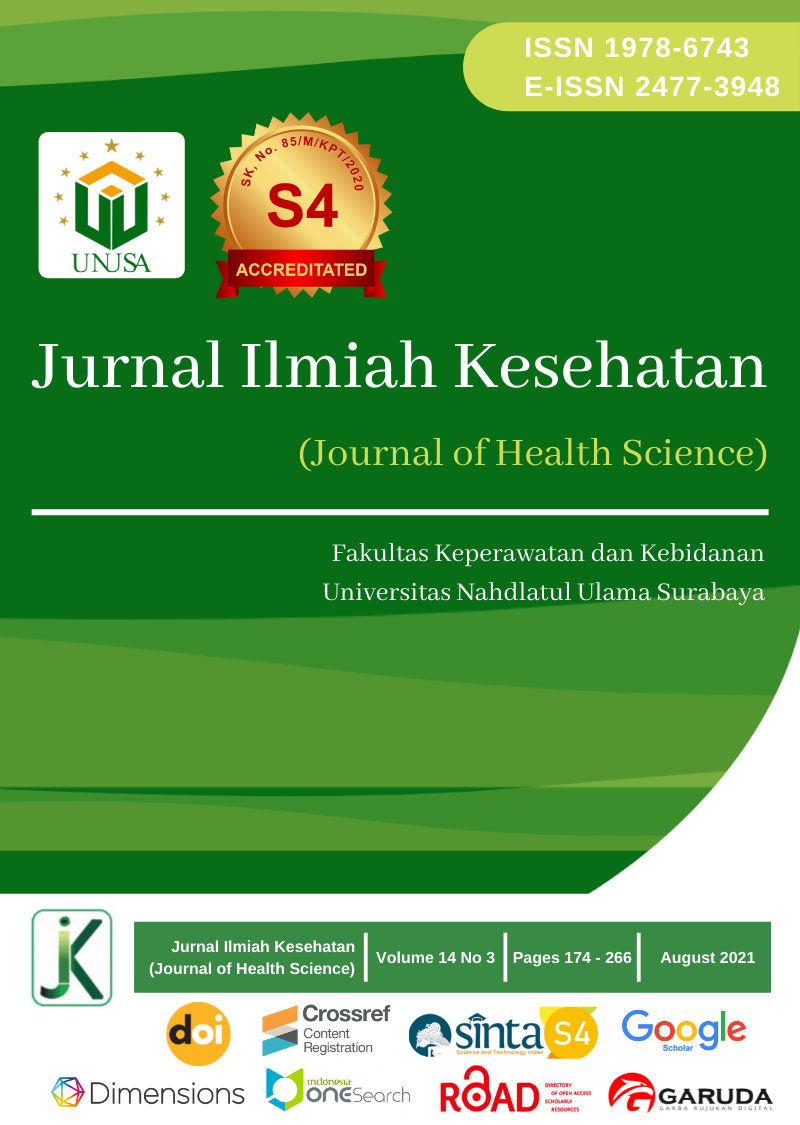Application of Nightingale's Environmental Theory: The Effect of Heliotherapy on The Clinical Improvements in Individuals with Tuberculosis
Main Article Content
Abstract
Tuberculosis is a global health problem. Sunlight can trigger vitamin D
production, so it increases the immunity system. This study analyses
Nightingale's environmental theory through the effect of heliotherapy on the
clinical improvements in individuals with tuberculosis. It was a quantitative
study using a quasi-experimental design with a pretest-posttest approach and a
control group. In addition, the population was 59 individuals with tuberculosis
in Depok Sleman District, Yogyakarta. Meanwhile, there were 24 respondents
by purposive sampling method. The intervention group at Depok 3 Public
Health Centre (PHC) was 17 respondents with heliotherapy and anti-
tuberculosis drugs, while the control group at Depok 2 PHC was 17
respondents with anti-tuberculosis drugs. The independent variable was
heliotherapy, while the dependent variable was the clinical improvements
consisting of weight, cough, and shortness of breath. Heliotherapy was
conducted for four weeks with an intensity of four times a week for 25
minutes a day. Instruments used weigh scale, Borg Scale, and Leicester cough
questionnaire. In addition, data analysis used the Wilcoxon Test and paired T-
Test with a significance of 0.05. The results showed that there were clinical
improvements in the intervention group (p=0.000). In addition, there were
increased clinical improvements in weight and cough scores in the control
group (p=0.000). However, there was no significant difference in the shortness
of breath score in the control group (p=0.06). In conclusion, the application of
Nightingale's environmental theory through heliotherapy affects clinical
improvements in individuals with tuberculosis.
Downloads
Article Details
Copyright (c) 2021 Liza Wijaya

This work is licensed under a Creative Commons Attribution-ShareAlike 4.0 International License.
References
Alligood, M R. 2017. Pakar Teori Keperawatan Dan Karya Mereka. 8th ed. ed. A Y Hamid. Elsevier.
Asyary, A., and M. Veruswati. 2020. “Sunlight Exposure Increased Covid-19 Recovery Rates: A Study
In The Central Pandemic Area Of Indonesia.” Science Of The Total Environment: 139016.
Emokpae, A A, C A Mabogunje, Z O Imam, and B O Olusanya. 2016. “Heliotherapy For Neonatal
Hyperbilirubinemia In Southwest, Nigeria: A Baseline Pre-Intervention Study.” Plos One 11(3): 1–
Handono, N. P., A. N. Ashifa, and A. A. Kristiawan. 2020. “Pengaruh Sinar Matahari Untuk
Meningkatkan Efektifitas Bersihan Jalan Nafas Pada Pasien Ppok Di Puskesmas Selogir.” Jurnal
Keperawatan Gsh 5(2): 7–11.
Hasanah, U., A. Permatasari, and E. Karota. 2016. “Hubungan Keluhan Pernapasan Dan Faktor
Psikologis Dengan Kualitas Tidur Pasien Penyakit Paru.” Jurnal Ners Indonesia 6(1): 45–50.
Jarrett, P, and R Scragg. 2017. “A Short History Of Phototherapy, Vitamin D And Skin Disease.”
Photochemical And Photobiological Sciences 16(3): 283–290.
Mandala, Z. 2015. “Hubungan Kenaikan Berat Badan Penderita Tb Paru Yang Sedang Mendapat
Pengobatan Intensif Dengan Konversi Hasil Pemeriksaan Bta Tahun 2012.” Jurnsl Medika
Malahayati 2(4): 177–182.
Masulili, F., Zainul, and Junaidi. 2017. “Pengaruh Sinar Ultraviolet Terhadap Kadar Vitamin D Dan
Tekanan Darah Pada Perempuan Di Pesantren Di Kota Palu.” Jurnal Keperawatan Sriwijaya 4(1):
–50.
LIZA NOVITASARI WIJAYA / JORNAL OF HEALTH SCIENCE – VOLUME 14 NO.03 (2021) E-ISSN: 2477-3948
https://doi.org/10.33086/jhs.v14i3.2161 Liza Novitasari Wijaya - Application of Nightingale's Environmental Theory: The
Effect of Heliotherapy on The Clinical Improvements in Individuals with
Tuberculosis
Sugiarti, S., and C. N. Ramadhian Mr. 2018. “Vitamin D Sebagai Suplemen Dalam Terapi Tuberkulosis
Paru.” 7(2): 198–202.
Turnbull, E. R., and F. Drobniewski. 2015. “Vitamin D Supplementation: A Comprehensive Review On
Supplementation For Tuberculosis Prophylaxis.” Expert Review Of Respiratory Medicine 9(3): 269–
Whittemore, P. B. 2020. “Covid-19 Fatalities, Latitude, Sunlight, And Vitamin D.” American Journal Of
Infection Control 48(9): 1042–1044.
WHO. 2016. “Global Tuberculosis Report.” European Respiratory Journal 44(1): 23–63.





